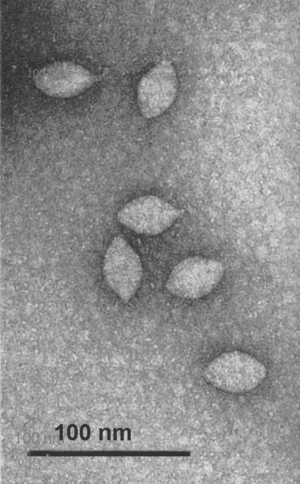Fuselloviridae: Difference between revisions
No edit summary |
No edit summary |
||
| Line 13: | Line 13: | ||
==Description and Significance== | ==Description and Significance== | ||
Fuselloviridae | Fuselloviridae infect the archaeon [[Sulfolobus]], which inhabits high-temperature (>70°C), acidic (pH of <4.0) environments. The Fuselloviridae family currently consists of only one virus, ''Sulfolobus'' spindle-shaped virus 1 (SSV1), and three tentative members (SSV2, SSV3, and the staaelite virus pSSVx, which stands for plasmid SSV x). SSV1, the type virus for the family, was the first high-temperature virus to be characterized. (source: [http://jvi.asm.org/cgi/content/full/78/4/1954?view=long&pmid=14747560 Wiedenheft et al.]) | ||
==Genome Structure== | ==Genome Structure== | ||
The genome of a fuselloviridae is | The genome of a fuselloviridae is non-segmented and contains a single molecule of circular, double-stranded DNA. The DNA is positively supercoiled. The complete genome is 15500 nucleotides in length. (source: [http://www.ncbi.nlm.nih.gov/ICTVdb/ICTVdB/28000000.htm ICTVdB]) | ||
==Virion Structure of a Fuselloviridae== | ==Virion Structure of a Fuselloviridae== | ||
Fuselloviridae virions consist of an envelope and a nucleocapsid. The capsid is enveloped. Virions are spindle-shaped, flexible, and have protrusions that extend through the envelope. One pole has short tail-like fibers attached to it. The virions are 100 nm in length and 60 nm in diameter. (sources: [http://www.ncbi.nlm.nih.gov/ICTVdb/ICTVdB/28000000.htm ICTVdB], [http://jvi.asm.org/cgi/content/full/78/4/1954?view=long&pmid=14747560 Wiedenheft et al.]) | |||
==Reproduction Cycle of a Fuselloviridae in a Host Cell== | |||
==Viral Ecology & Pathology== | ==Viral Ecology & Pathology== | ||
As mentioned above, viruses in the Fuselloviridae family infect the archaeon [[Sulfolobus]]. | |||
==References== | ==References== | ||
[http://www.ncbi.nlm.nih.gov/ICTVdb/ICTVdB/ | [http://www.ncbi.nlm.nih.gov/ICTVdb/ICTVdB/28000000.htm ICTVdB - The Universal Virus Database, version 3. http://www.ncbi.nlm.nih.gov/ICTVdb/ICTVdB/] | ||
[http://jvi.asm.org/cgi/content/full/78/4/1954?view=long&pmid=14747560 Wiedenheft et al. "Comparative Genomic Analysis of Hyperthermophilic Archaeal Fuselloviridae Viruses." ''Journal of Virology'' 78.4 (2004): 1954-1961.] | |||
Revision as of 20:50, 11 July 2006

Baltimore Classification
Higher order taxa
Viruses; dsDNA viruses, no RNA stage; Fuselloviridae
Genera
Fusellovirus
Description and Significance
Fuselloviridae infect the archaeon Sulfolobus, which inhabits high-temperature (>70°C), acidic (pH of <4.0) environments. The Fuselloviridae family currently consists of only one virus, Sulfolobus spindle-shaped virus 1 (SSV1), and three tentative members (SSV2, SSV3, and the staaelite virus pSSVx, which stands for plasmid SSV x). SSV1, the type virus for the family, was the first high-temperature virus to be characterized. (source: Wiedenheft et al.)
Genome Structure
The genome of a fuselloviridae is non-segmented and contains a single molecule of circular, double-stranded DNA. The DNA is positively supercoiled. The complete genome is 15500 nucleotides in length. (source: ICTVdB)
Virion Structure of a Fuselloviridae
Fuselloviridae virions consist of an envelope and a nucleocapsid. The capsid is enveloped. Virions are spindle-shaped, flexible, and have protrusions that extend through the envelope. One pole has short tail-like fibers attached to it. The virions are 100 nm in length and 60 nm in diameter. (sources: ICTVdB, Wiedenheft et al.)
Reproduction Cycle of a Fuselloviridae in a Host Cell
Viral Ecology & Pathology
As mentioned above, viruses in the Fuselloviridae family infect the archaeon Sulfolobus.
References
ICTVdB - The Universal Virus Database, version 3. http://www.ncbi.nlm.nih.gov/ICTVdb/ICTVdB/
